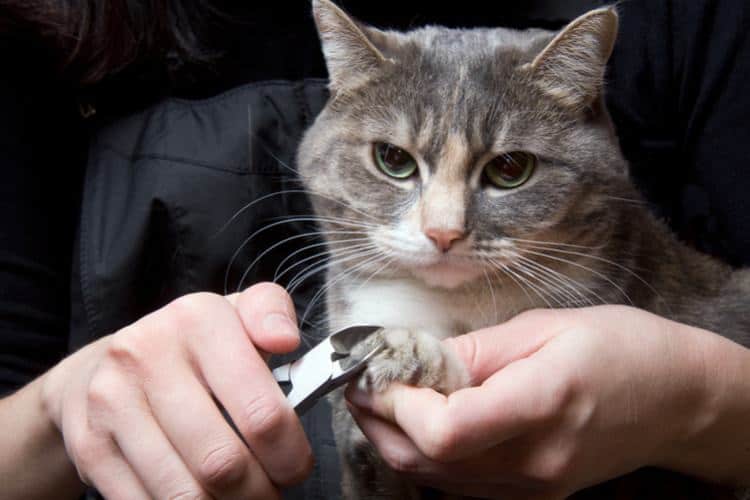Aside from being slightly irritating, sharp cat claws scuffing your carpet may seem harmless. At worst, you spot a piece that you have to cover with a lamp and teach your cat to finally start using that expensive scratching post. However, sharp claws can cause more than damage to your carpet or a tear in your favorite t-shirt; they can cause pain or injury to your cat. Fortunately, that’s entirely avoidable by trimming your cat’s nails regularly, and you can learn to do so in the comfort of your home.
Here are eight simple steps on how to trim cat nails:
Remember, the more times you trim your cat’s nails, the more confident both of you will feel about it. To ensure you and your cat are as prepared as possible for the trim, review the steps in more detail below.
Step 1: Purchase and Gather the Supplies You’ll Need to Trim Your Cat’s Nails
If this is the first time you are trimming your cat’s nails, you will need clippers. There are different types and sizes so choose one that you are most comfortable using. If your pet is a kitten, you can use human nail clippers, turned sideways, to trim smaller claws.
You will also need to gather treats, a small blanket or towel, and styptic powder (used to stop bleeding) just in case.
Step 2: Assess Your Cat’s Mood
Trimming your cat’s nails will only work if the cat is feeling calm and happy. If the cat’s in a ball of energy or feeling grumpy, wait until a better time.
Step 3: Find a Place in Your Home Where Your Cat Will Be Comfortable
The room should be quiet with minimal distractions so your cat does not have the urge to move suddenly. Make sure there’s enough light in the room for you to see the nails clearly.
Step 4: Test Your Cat’s Reaction to the Noise of the Clippers
If your cat isn’t used to having its nails trimmed, your pet may be spooked or irritated by the experience. To show your cat that it is a painless, simple process, take a piece of uncooked spaghetti and place it next to him. Then, clip the strand and give your cat some positive attention.
Step 5: Place the Cat in the Position to Cut His Nails, and Make Sure He’s Comfortable
The cat should be sitting on your lap, facing away from you so you are able to stabilize the cat’s paw as you trim the nails. If the cat starts to fidget, wait until your pet is comfortable to start.
You know what your pet finds soothing—whether it is to be scratched on the stomach, tickled behind the ears, or wrapped in a blanket. Just like a newborn baby finds comfort in being swaddled, some cats are soothed when they are tightly cradled in cloth. Check out Vetstreet to learn how to towel-wrap your cat and expose its legs when it comes time to clip the nails.
Step 6: Take Hold of the First Paw and Push Down Gently on the Pad with Your Thumb to Expose the Claws
If your cat is nervous, take one of the paws and massage it. Continue to pet the cat and give reassurance that everything is fine. Once the cat is comfortable with you touching their paws, press your thumb into the pad of the paw to make the claws visible.
Step 7: If the Claws Have a Pointed Tip, Trim the Ends One at a Time with the Clippers
Only trim the tips of the claws. If you cut too far, you may cut the quick of the nail. The quick is the pink part of the nail and contains blood supply, so it will be painful and bleed if it is cut. If you accidentally cut the quick, use styptic powder stop the bleeding, and wait to finish trimming the rest of the nails later.
Step 8: Praise Your Cat for Calm Behavior and Pause if He’s Irritated
As you trim each nail, offer your cat some positive reinforcement. If your cat is uncomfortable or irritated by the process, take a break and try again later. Once all the nails are trimmed, reward your cat with a treat or some special food to help the cat associate the experience with a positive result.
Just as you would teach a child to brush his or her teeth at a young age, starting to clip your cat’s nails when the cat is young will teach your pet that it is normal and necessary. Plus, you will avoid being scratched and your cat will avoid injuries and infections that can be a result of long or ingrown nails.
Do you have a dog? Learn how to trim your dog’s nails.
Featured Image Credit: tandemich, Shutterstock
























